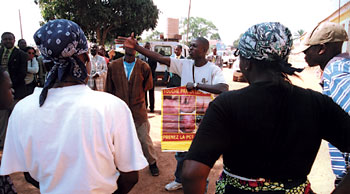| ANGOLA’S CHALLENGE |
|
Leprosy in Angola
By Dr. Yo Yuasa, Executive and Medical Director, Sasakawa Memorial Health Foundation
|
| The Republic of Angola, a former Portuguese colony, has, since independence, suffered from a series of lengthy
civil conflicts and has had a relatively poor healthcare system in general, compared to the countries in the
southern part of Africa, a majority of which were either British or French colonies before their independence. |
As a result, Angola is one of only six remaining leprosy-endemic countries in the world.
The latest official number of registered cases was 5,245, making the national prevalence rate
3.54/10,000. This indicates some improvement, since in 1973 it was reported to be 5.2/10,000, yet progress has been very slow, casting some
doubt on the potential to lower it to less than 1/10,000. Additionally, the deformity rate among newly detected cases was a relatively high 13 percent, indicating some
delay in case detection. The child rate among new cases was 11.9 percent. Again this is somewhat high, but considering the young demographic profile of the country, it is perhaps not overly high, though it certainly
indicates existing active leprosy transmission. |
It was only in 1994, much later than in most other countries, that MDT was introduced. It then became
available in all provinces by 1998. At present, 75% of existing health units are reported to have implemented MDT.
One notable phenomenon is the recent increase of
case detection. This does not indicate an actual increase of new cases, but is a reflection of an increase in field
activities. This resulted in a case detection rate of 12.49/100,000 in 1998, 17.62/100,000 in 2001 and 28.83/
100,000 in 2002. This trend will hopefully lead in the near future to the detection of all backlogged cases,
resulting in a case detection rate closer to the actual incidence rate which in turn should be much lower than
the current figures.
According to the ministry of health’s three-year strategic plan for leprosy (2003-2005), three main areas need to be tackled. |
| |

IEC: Health Education Campaign in Angola |
| |
| 1) Training of health staff, so that all health units can implement MDT, improve the efficiency of case
detection, and achieve higher accuracy in diagnosis and classification. Maintenance of more up-to-date case
records and implementation of an efficient reporting system is also vital. |
| 2) Strengthening social mobilization with better IEC material, so that people will have more
interest and a better understanding of leprosy. |
3) Improving POID (Prevention of Impairment and Deformities) and “care after cure” activities so that
fewer patients will suffer from residual physical or social problems.
The ministry would like to accomplish the above through the following methods: |
| ・ Integration of all leprosy control activities into the general health services to improve accessibility to patients, as well as attain sustainability of leprosy activities. |
・ Better coordination of all potential partners, especially in view of the existence of the long and committed involvement of NGOs.
While there are several excellent medical and social programs being run in Angola by NGOs, in some other areas, armed conflict
has nearly destroyed whatever they had in the past, and large numbers of refugees have created additional problems. |
As in most developing countries, leprosy is by no means the top priority health issue in Angola. However,
because it is a chronic, non-lethal and deformity producing disease, it remains one of the more serious
social burdens, which tends to hinder improvement of national living standards, far beyond the relatively small
number of actual cases.
Angola is not a highly developed country, but that in itself should not prevent it from improving health care.
With carefully chosen priorities and attention to logistic details, health services can improve. It is hoped that not only will the elimination of leprosy be achieved in time,
but that improved health care for those in need will also be provided. |
|